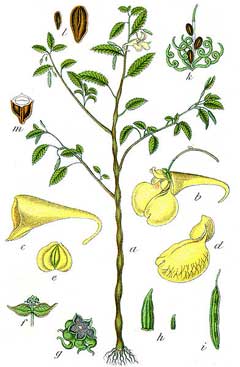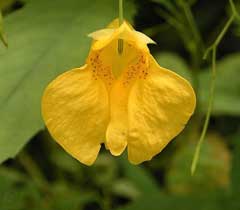 |
|
http://commons.wikimedia.org/wiki/File:Impatiens_noli-tangere_Sturm13.jpg |
 |
| http://commons.wikimedia.org/wiki/User:Ies |
Translate this page:
Summary
Physical Characteristics

 Impatiens noli-tangere is a ANNUAL growing to 1 m (3ft 3in).
Impatiens noli-tangere is a ANNUAL growing to 1 m (3ft 3in).
See above for USDA hardiness. It is hardy to UK zone 6. It is in flower from July to September, and the seeds ripen from August to October. The species is hermaphrodite (has both male and female organs) and is pollinated by Insects.
Suitable for: light (sandy), medium (loamy) and heavy (clay) soils and can grow in heavy clay soil. Suitable pH: mildly acid, neutral and basic (mildly alkaline) soils. It can grow in semi-shade (light woodland) or no shade. It prefers moist soil.
UK Hardiness Map
US Hardiness Map
Synonyms
Plant Habitats
Woodland Garden Sunny Edge; Dappled Shade; Shady Edge; Bog Garden;
Edible Uses
Edible Parts: Leaves Seed Shoots
Edible Uses:
Young shoots - cooked[105, 172]. See the notes above on toxicity. Seed - raw. A delicious nutty flavour but rather difficult to harvest[172], mainly because of their exploding seed capsules which scatter the ripe seed at the slightest touch[K].
References More on Edible Uses
Medicinal Uses
Plants For A Future can not take any responsibility for any adverse effects from the use of plants. Always seek advice from a professional before using a plant medicinally.
Antiseptic Diuretic Emetic Laxative
The plant is antiseptic, diuretic, strongly emetic, laxative and vulnerary[4, 9, 61]. It has been used in the treatment of stranguary and haemorrhoids[4]. The plant is occasionally used internally in the treatment of haemorrhoids and as a laxative and diuretic, but the dose must be carefully adhered to since large quantities are strongly emetic[9]. The plant is harvested at any time in the summer[9].
References More on Medicinal Uses
The Bookshop: Edible Plant Books
Our Latest books on Perennial Plants For Food Forests and Permaculture Gardens in paperback or digital formats.

Edible Tropical Plants
Food Forest Plants for Hotter Conditions: 250+ Plants For Tropical Food Forests & Permaculture Gardens.
More

Edible Temperate Plants
Plants for Your Food Forest: 500 Plants for Temperate Food Forests & Permaculture Gardens.
More

More Books
PFAF have eight books available in paperback and digital formats. Browse the shop for more information.
Shop Now
Other Uses
References More on Other Uses
Cultivation details
Succeeds in any reasonably good soil[1]. Grows well in heavy clay soils. Prefers a moist well-drained humus rich soil in a cool site[200]. Self sows in areas where the minimum temperature is no lower than -15°c[200]. This plant has seed capsules that spring open forcibly as the seed ripens to eject the seed a considerable distance. The capsules are sensitive to touch even before the seed is ripe, making seed collection difficult but fun[K].
References Carbon Farming Information and Carbon Sequestration Information
Temperature Converter
Type a value in the Celsius field to convert the value to Fahrenheit:
Fahrenheit:
The PFAF Bookshop
Plants For A Future have a number of books available in paperback and digital form. Book titles include Edible Plants, Edible Perennials, Edible Trees,Edible Shrubs, Woodland Gardening, and Temperate Food Forest Plants. Our new book is Food Forest Plants For Hotter Conditions (Tropical and Sub-Tropical).
Shop Now
Plant Propagation
Seed - sow spring in a greenhouse. A period of cold stratification may help to improve germination rates. When they are large enough to handle, prick the seedlings out into individual pots and plant them out in the summer. If you have sufficient seed, it is worthwhile trying an outdoor sowing in situ in the spring or the autumn[4].
Other Names
If available other names are mentioned here
Native Range
TEMPERATE ASIA: Iran (north), Turkey, Russian Federation-Ciscaucasia (Ciscaucasia), Armenia, Azerbaijan, Georgia, Russian Federation (Dagestan), Russian Federation-Western Siberia (Western Siberia), Russian Federation-Eastern Siberia (Eastern Siberia), Kazakhstan (southeast), Kyrgyzstan, Mongolia, Russian Federation (Habarovskij kraj, Primorye, Amur, Kamcatskij kraj, Magadanskaja oblast, Sakhalin), China (Hebei Sheng, Heilongjiang Sheng, Henan Sheng, Jilin Sheng, Liaoning Sheng, Nei Mongol Zizhiqu, Shaanxi Sheng, Shandong Sheng, Shanxi Sheng, Zhejiang Sheng), Korea, Japan (Hokkaidô, Honshu, Kyushu, Shikoku) NORTHERN AMERICA: United States (Alaska, Idaho, Oregon, Washington), Canada (Saskatchewan, Alberta, Manitoba, British Columbia) EUROPE: Denmark, Finland, United Kingdom, Norway, Sweden, Austria, Belgium, Switzerland, Czech Republic, Germany, Hungary, Netherlands, Poland, Slovakia, Russian Federation (European part), Belarus, Estonia, Lithuania, Latvia, Moldova, Ukraine (incl. Krym), Bulgaria, Bosnia and Herzegovina, Greece, Italy, North Macedonia, Montenegro, Romania, Serbia, Slovenia, Spain, France
Weed Potential
Right plant wrong place. We are currently updating this section.
Please note that a plant may be invasive in one area but may not in your area so it's worth checking.
Conservation Status
IUCN Red List of Threatened Plants Status :

Growth: S = slow M = medium F = fast. Soil: L = light (sandy) M = medium H = heavy (clay). pH: A = acid N = neutral B = basic (alkaline). Shade: F = full shade S = semi-shade N = no shade. Moisture: D = dry M = Moist We = wet Wa = water.
Now available:
Food Forest Plants for Mediterranean Conditions
350+ Perennial Plants For Mediterranean and Drier Food Forests and Permaculture Gardens.
[Paperback and eBook]
This is the third in Plants For A Future's series of plant guides for food forests tailored to
specific climate zones. Following volumes on temperate and tropical ecosystems, this book focuses
on species suited to Mediterranean conditions—regions with hot, dry summers and cool, wet winters,
often facing the added challenge of climate change.
Read More
Expert comment
Author
L.
Botanical References
17
Links / References
For a list of references used on this page please go here
Readers comment